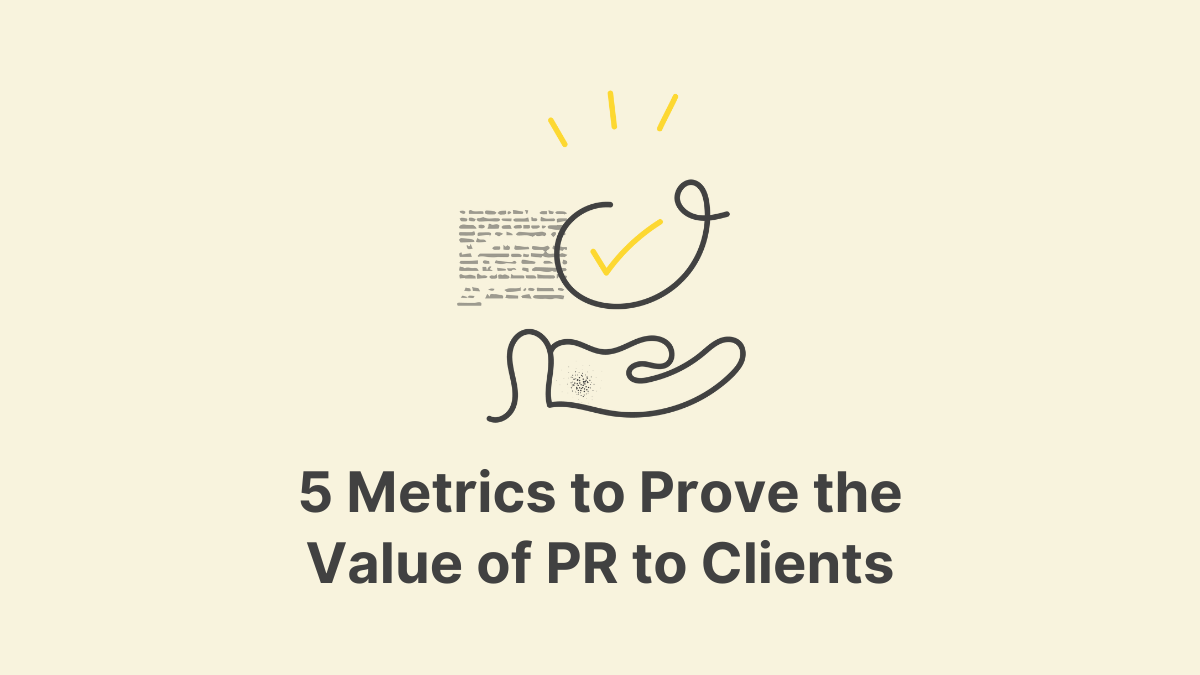5 Metrics to Prove the Value of PR to Clients

In the era of all things digital, the measurable value of PR for brand awareness is often the first strategy to fall under a microscope or get dismissed when discussing a marketing budget. PR pros are constantly under pressure to showcase the tangible benefits of their efforts to clients. Gone are the days when a well-placed article or an impressive press release was enough; now, professionals need to back up their successes with concrete data.
When clients are asking for objective metrics to showcase the value of PR efforts, publicists and small agency PR pros can use these five key metrics:
1. Media impressions
What it measures: The potential number of times a person is exposed to a message or content piece across various channels over a certain period of time.
Why it's valuable: While media impressions don’t precisely measure how many people actually consumed the content, they provide a ballpark figure of the content’s reach. High media impressions indicate that your PR activity is casting a wide net.
Pro PR tip: Don't just rely on raw numbers. Diversify your reach across various mediums – print, digital, broadcast, etc. – and consider the credibility of each channel and the target audience the client is trying to reach. For example, if a health technology client’s goal is to reach heart surgeons, a healthcare trade publication may be a stronger win than TechCrunch.
2. Share of voice (SoV)
What it measures: How frequently your brand is mentioned in comparison to your competitors within industry conversations.
Why it's valuable: A high SoV means that your brand dominates the conversation in your industry or niche. It’s a sign that your PR efforts are effectively positioning your brand as a thought leader or major player.
Pro PR tip: Use tools like Google Alerts or Brandwatch to monitor brand mentions and analyze your SoV compared to competitors.
3. Website traffic and referral sources
What it measures: The amount of traffic driven to your website from PR efforts, and where that traffic is coming from.
Why it's valuable: A surge in website traffic following a PR campaign or activity indicates successful audience engagement. Monitoring referral sources can help you identify which PR channels or publications are most effective.
Pro PR tip: Google Analytics is your friend here. Use it to dive deeper into referral traffic sources, session duration, and bounce rates to understand user behavior post-PR activity. But during your pitching, be careful to avoid using UTM tracking codes in your links. Some journalists find it offputting and spammy.
Using a tool like OnePitch to send your pitches to journalists allows you to track metrics like email opens, clicks, and reactions so you have a better understanding of journalist activity and how to move forward with your follow-up strategy. These are also important metrics for clients when it comes to pitching effectiveness and outreach in general.
4. Message pull-through
What it measures: How effectively your brand's key messages are communicated and retained in media coverage.
Why it's valuable: PR isn't just about getting coverage; it's about ensuring that the coverage aligns with your brand's narrative. This metric ensures your key messages aren't lost in translation.
Pro PR tip: Craft compelling, clear, and concise key messages. Then, analyze a sampling of media coverage to gauge how often those messages are incorporated. This is a great data point to share with clients that requires no hard numbers or metrics.
5. Engagement and sentiment analysis
What it measures: How people are interacting with your PR content and their feelings towards it.
Why it's valuable: It's one thing to get your content in front of eyes; it's another to prompt action. High engagement (likes, shares, comments, retweets) demonstrates that the content resonates. Meanwhile, sentiment analysis helps gauge public perception, whether positive, neutral, or negative.
Pro PR tip: Use social listening tools and sentiment analysis platforms to gather insights and be willing to pivot your strategies based on the sentiment and feedback from your target audiences.
While there's no one-size-fits-all approach to proving the value of PR, these five metrics are a starting point. As your PR strategy continues to evolve with your clients based on their goals, so should your ways of measuring its impact. Stay agile, continue to learn, and always strive to demonstrate the tangible benefits of your work to your clients so they stay your clients and partners for the long haul.
Want access to pitching metrics like email open rate, click rate, response rate, and more? Try out OnePitch for free with a 14-day trial. Create your account now!
______
Want to land a placement in a top publication like Forbes? Try OnePitch for free, submit your client/brand information, get your curated media list, and start pitching directly on your OnePitch profile.
From an agency reporter to senior editors, learn how to pitch journalists on #CoffeeWithAJournalist. See more examples of pitches that landed on The TypeBar.
Do you have a pitch that landed your client exceptional coverage that you want to highlight? Email us at info@onepitch.co with your pitch and 3-5 reasons why you believe it worked.
Want more blogs like this?
Fill out the form below to subscribe to our newsletter and receive emails with the top blogs from The TypeBar!
